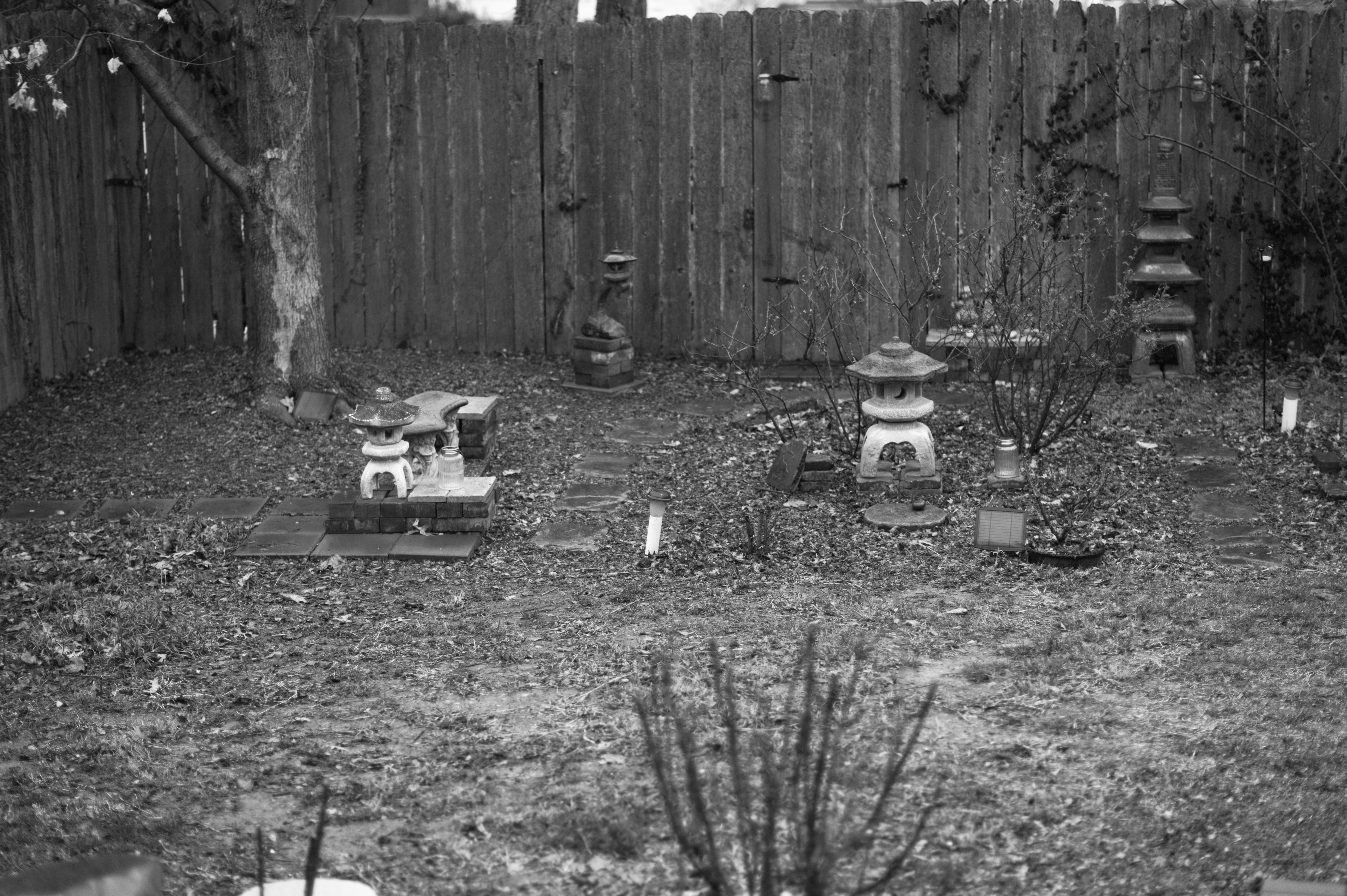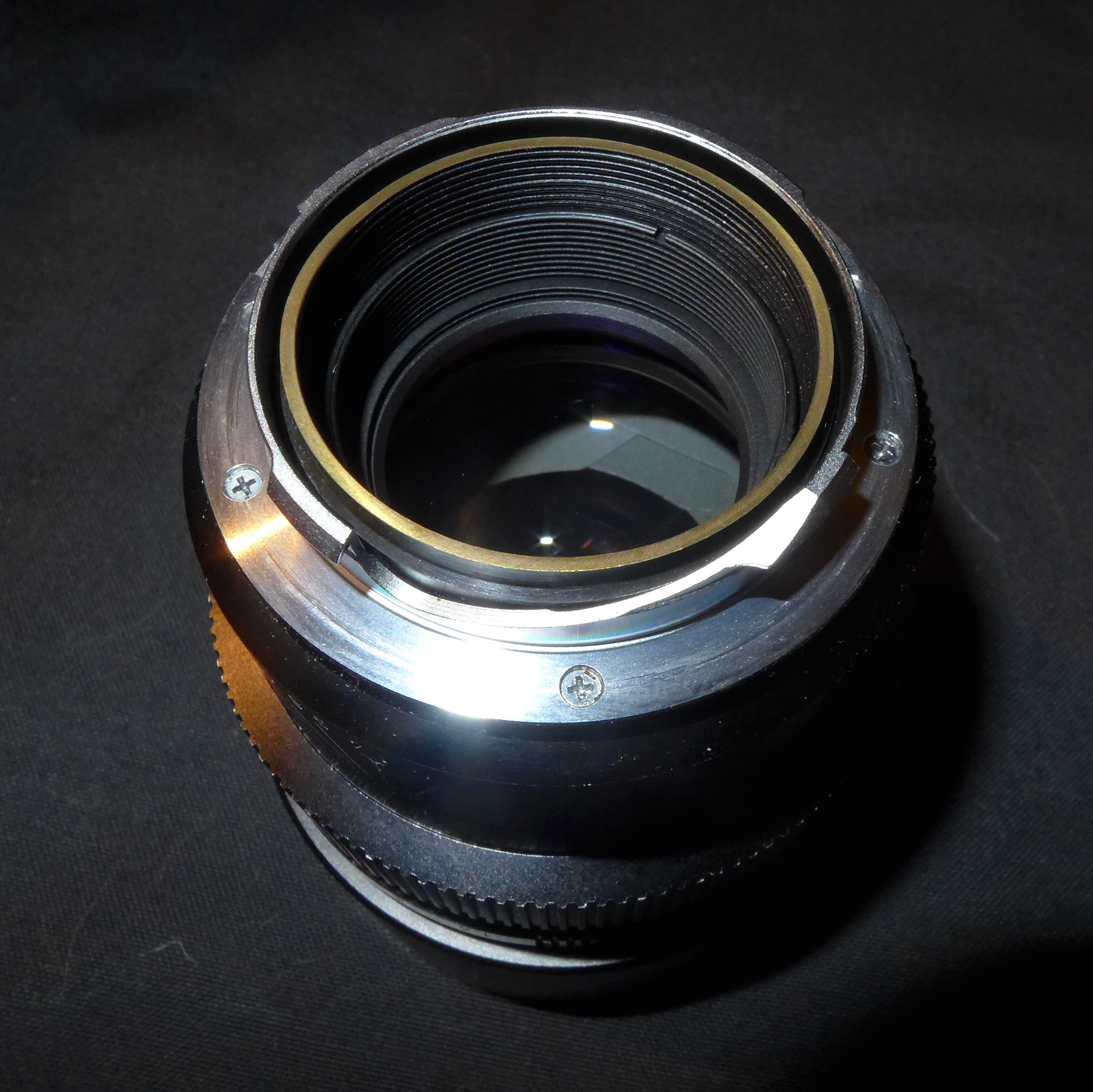Rob-F
Likes Leicas
I can't seem to pry this lens loose from my hands, so now I'm leaning towards keeping it. I could ask DAG to code it while he has it. Might as well.

The focus point is the Japanese lantern near center. Looks pretty decent, at least as an experiment, even though not the long-term solution.
Yes four inches is about right. I tried re-shooting a backyard scene that had come out OOF, this time turning the focus ring to a slightly closer distance, in order to compensate, as Marty described. I moved it in several small increments and then picked the closest guess once I had it up on the monitor.It’s focusing about 4 inches behind the focus point. Interesting. I’d say it’s most likely that it’s out of spec, but there are no guarantees.
Pack it well when you send it, whether that is back to the seller or to DAG. The aperture mechanism is partly plastic and glued together and sensitive to knocks. They are all like that by the way.
Marty

The focus point is the Japanese lantern near center. Looks pretty decent, at least as an experiment, even though not the long-term solution.
Rob-F
Likes Leicas
I will photograph the back of the lens in the morning. I could try the longer-distance test by shooting fence pickets. I can do Five Meters, and maybe 10 Meters. my yard isn't 20 Meters long.Can you post an image of the back of the lens? From what I see online- the first type lens uses a "tongue" type RF Cam, later types uses a rotating indexed cam. The simple fix for back-focus with the tongue type - I use one layer of copper tape, or on a severe case- two layers. I had to do this for the Nokton 50/1.1 and Nokton 35/1.2 V1 that were optimized for the Voigtlander film cameras when using on my M9.
The second test- do the same type focus test over the full range, close-up as you have done, at 5m, and out to 20m. If the back-focus disappears and becomes a front focus, the focal length of the lens is off. If the error is a continuous back-focus, building up the Cam will work.
$400 discount. If the back focus is consistent and repeatable- then the problem should be easily correctable. If it is not repeatable, and varies with distance and the angle that the lens is held- might be a loose optic or sloppy helical. The latter- with the lens on the camera, work the focus and push down on the lens. If the RF image is affected by pushing down slightly on the lens, the helical is worn. I've seen all of these problems affect focus of a lens. 50/1.5 Asph Nokton- focused propery when held level or pointed up. Lost focus when pointed down. One of the inner retaining rings was not properly tightened down. Worn Helical- Leica Elmar, Wartime LTM Sonnar, and Many J-8 and J-3. Vacuum Pump Grease.
On vacation this week- my Daughter is on Spring Break. But will check in...
raid
Dad Photographer
I have a Canon 50/1.2 LTM that once had a weird focusing issue; it was sharp diagonally across the image but not where you focus. Two well known camera repair people could not fix this problem, and then Don Goldberg got my lens. He eventually identified the problem as internal lens parts having moved, and after he fixed it, it became a very sharp lens. I posted some images from it, and one of these images showed a man with a beard. Erik then commented "you can count each hair", referring to the sharpness of the lens.
I hope that Don can fix your Summilux very well.
----------------
I found the image!

I hope that Don can fix your Summilux very well.
----------------
I found the image!

Rob-F
Likes Leicas
Here'e the photo of the back end of the 75mm Summilux. It's the version II, with collapsible hood.


raid
Dad Photographer
Are all such lenses Version II when having a collapsible hood? Mine also has a collapsible hood.
The Cam in this lens rotates with the focus, and note the cut in the cam, which is a fine-tune for the focus. That most likely needs to be "rotated" to correct the focus. This is a job for DAG, is something he's done for several RFF members.
raid
Dad Photographer
I was lucky then. My Lux never needed any adjusting.
f.hayek
Well-known
Type I (Canada) has a separate detachable hood, Type II (Canada) built-in retractable hood, Type III (Germany) redesigned lens barrel, built-in retractable hood and something like 50 or 60 grams lighter.Are all such lenses Version II when having a collapsible hood? Mine also has a collapsible hood.
Last edited:
raid
Dad Photographer
My lens is then Type III as it states on it Made in Germany. I have not noticed any flaws of any sort on this lens. I have it right now in my camera bag, attached to an M10. The M9 has with it a 35mm/2 Made in China "replica" while the original Summicron is resting.
f.hayek
Well-known
Be gentle with the Summilux because that version commands ~ $4-5k nowadays.My lens is then Type III as it states on it Made in Germany. I have not noticed any flaws of any sort on this lens. I have it right now in my camera bag, attached to an M10. The M9 has with it a 35mm/2 Made in China "replica" while the original Summicron is resting.
raid
Dad Photographer
I am careful but I use this lens. WOW. 4~5 k $ is a lot of money. I bought the Lux 35/1.4 from the same seller then. Both lenses seem to have appreciated in value. Same applies to the 8 element 35/2 Summicron.
Last edited:
Rob-F
Likes Leicas
I don't seem to see a cut in the cam. Where should I be looking? Is it what looks like a slight depression in the surface?The Cam in this lens rotates with the focus, and note the cut in the cam, which is a fine-tune for the focus. That most likely needs to be "rotated" to correct the focus. This is a job for DAG, is something he's done for several RFF members.
The cam can be rotated? That's great news! I was starting to worry, after another post said these problems are fixed with tape!
Last edited:
Rob-F
Likes Leicas
Is the 75mm Summilux going for as high as $5K? Maybe that's for the version 3. I paid about $3000. I'm sure I didn't get that much for the one I had previously, and sold. I thought it was in great shape, although the buyer, I remember, told me the focus was off. He supposed that I might not have shot with it wide open, which is probably right. I only remember using it outdoors in the daylight. So for the 75 Lux to become misadjusted may be a common occurrence.I am careful but I use this lens. WOW. 4~5 k $ is a lot of money. I bought the Lux 35/1.4 from the same seller then. Both lenses seem to have appreciated in value. Same applies to the 8 element 35/2 Summicron.
Rob-F
Likes Leicas
If it says "Made in Germany" I would think it is type 3, that is consistent with what it says in my reference book. But something to check is the weight: the type 3 was redesigned to make it a little lighter than type 2. my book is upstairs, but if you have a scale I can post the weights for types 2 and 3. Here we go: type 2, 600 grams; type 3, 560 grams.My lens is then Type III as it states on it Made in Germany. I have not noticed any flaws of any sort on this lens. I have it right now in my camera bag, attached to an M10. The M9 has with it a 35mm/2 Made in China "replica" while the original Summicron is resting.
Last edited:
raid
Dad Photographer
I don't have proper scales for such a weight. I have a small post scales for letters. I also have scales for humans to weigh with. I believe your numbers, Rob. 560 Grams. I got lucky by having the Type III. No clue why a Made in Germany lens sells for more money than a Made in Canada one.
f.hayek
Well-known
Really no reason for this. Exactly the same optical formula and optical cell.No clue why a Made in Germany lens sells for more money than a Made in Canada one.
I'd imagine the coatings were upgraded between 1980 and 2005. That should be it.
DRSummi
Member
Cachet of Made in Germany. The German manufactured lenses were the last productions and 40 grams lighter. 11810 should be clearly engraved into the black anodized lens body; no white paint fill.
raid
Dad Photographer
This one sells for less than $3k:
Rob-F
Likes Leicas
Even for a Mandler-designed lens? Is there no special cachet for "Made in Canada" even for a Mandler lens made in canada during the time Mandler was there?Cachet of Made in Germany. The German manufactured lenses were the last productions and 40 grams lighter. 11810 should be clearly engraved into the black anodized lens body; no white paint fill.
And is it possible that 40 grams (1.4 ounces) is worth another 1,000 or 2,000 to Leica enthusiasts?
Apparently anything can happen, once a Leica item becomes collectible!
Mackinaw
Think Different
I paid $500 for my type 1 when I bought it back in 2005 (or so).
Jim B.
Jim B.
Share:
-
This site uses cookies to help personalise content, tailor your experience and to keep you logged in if you register.
By continuing to use this site, you are consenting to our use of cookies.

